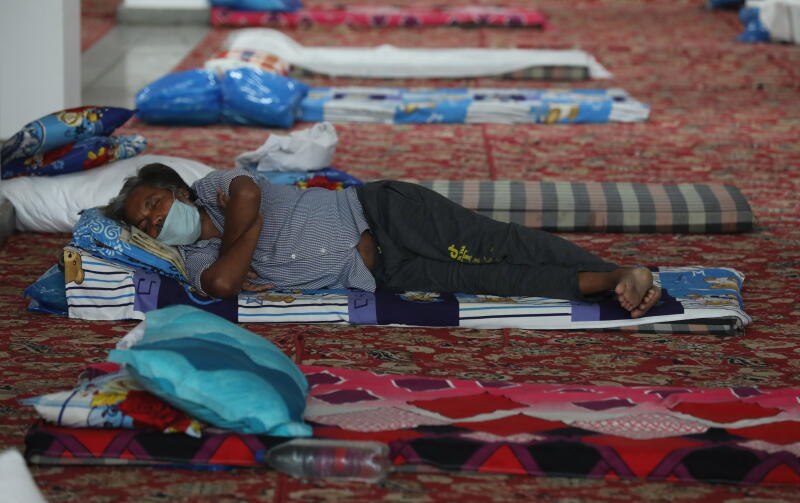India's lockdown throws up challenge of containing coronavirus and taking care of the poor
Sign up now: Get insights on Asia's fast-moving developments

A man resting in a shelter in New Delhi on April 14, 2020.
PHOTO: EPA-EFE
Follow topic:
NEW DELHI - Prime Minister Narendra Modi's announcement that some economic activity could resume in some parts amid one of the world's most stringent lockdowns underlines India's challenge of containing the coronavirus and the economic stress that is hitting the poor the hardest.
The next three weeks are expected to be crucial in India's fight against the virus and will determine if it moves towards flattening the curve in spite of its population of 1.35 billion and a weak health infrastructure.
Mr Modi extended the lockdown until May 3 but announced that some economic activity could resume in areas that are not hot spots after April 20 to ease economic distress, mainly for daily wage labourers.
The lockdown has been harshest on the poor, with the World Bank warning that the significant gains made in poverty alleviation in South Asia, including India, are likely to be erased by the fallout from the virus.
The bank also projected that India's economy to grow between 1.5 and 2.8 per cent in 2020-21, down from an estimate of 6.3 per cent six months ago.
"India is a poor country and has taken strong measures and that combination is really hurting us," said Professor Amit Basole from Azim Premji University in Bangalore.
"Lifting the restrictions (after April 20) will be the trickiest part - how to lift and who to allow. Factories or construction sites, where a lot of people are already on site, would be relatively easy."
Already signs of stress are emerging as hundreds of thousands of daily wage workers wait in community shelters for the lockdown to be lifted so that they can go home.
The announcement of a lockdown extension saw thousands of migrant workers congregate at a station in Mumbai, among the worst-affected cities in India, protesting and seeking to go home.
Last week, hundreds of migrants in the city of Surat in Gujarat state reportedly took to the streets demanding salaries and permission to go home.
"It's really worrying. Every day is a hardship (for the poor). These kinds of incidents could come up more. There is need for a huge increase in fiscal support, in some form of cash transfer, for the poor," said Prof Basole.
The government had announced a 1.7 trillion rupee (S$31.6 billion) economic package for the poor, but experts believe much more is needed to alleviate growing economic stress.
India took strict measures to control the spread of Covid-19 early into the outbreak when there were around 300 cases.
It banned the entry of foreigners from countries with high infection numbers like Italy and systematically grounded international flights, followed by domestic flights, public transport and train services. Mr Modi announced a three-week lockdown, initially until April 14.
That may have bought time for the country to prepare for the peak of the infection and may have even flattened the curve.
But has India done enough to prepare for the weeks ahead amid predictions that the peak will likely happen as quickly as the end of the month?
The government believes it has. Officials have spoken of how the country is aiming for "over-preparedness".

Still, health experts believe India may not even have the full picture of the spread of the virus in the absence of widespread testing.
India is testing up to 18,000 samples a day, with an intention to ramp it up to 100,000.
"You should see the curve deviating from its previous angle to say the lockdown has been completely successful," noted virologist T. Jacob John, who earlier headed the Indian Council for Medical Research's Centre for Advanced Research in Virology.
One key gauge of preparedness for fighting the virus is seen to be the availability of personal protection equipment and ventilators.
The government has identified 14,000 ventilators in various hospitals for the treatment of Covid-19 patients and has ordered 49,000 more, mainly from domestic manufacturers.
"Due to low Customs duties and lack of policy support in past, had the Indian medical device industry been more robust and better protected, the manufacturers of masks and PPE (personal protection equipment) kits would have been... better placed to ramp up capacities," said Mr Rajiv Nath, forum coordinator at the Association of Indian Medical Devices Industry.
The Health Ministry said 17 million PPE sets have been ordered from 20 domestic suppliers.
"The race is on," said Mr Nath.

